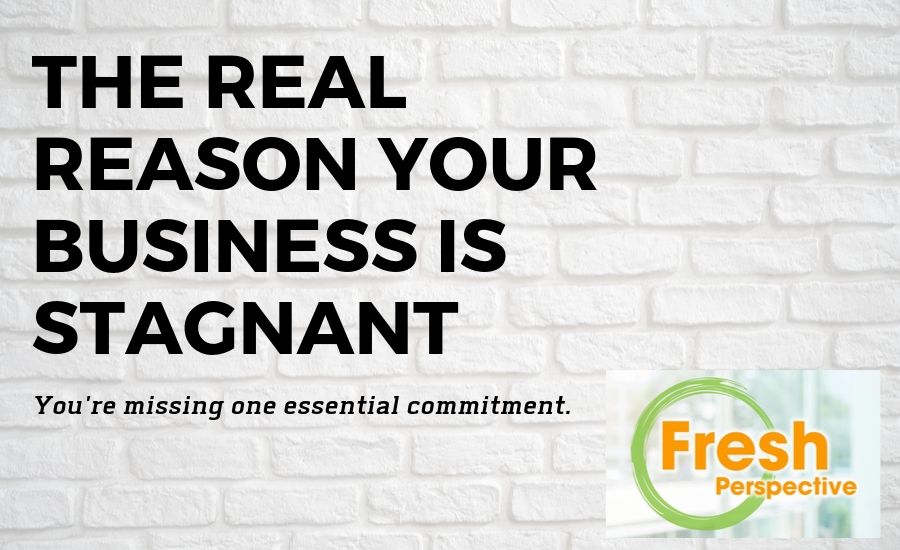Fresh Perspective
The Real Reason Your Business is Stagnant |Fresh Perspective Vol. 1
You're missing one essential commitment.

You have a great idea that’s going to take your company to the next level. Maybe you’ve finally discovered a point of connection with your dream client, and now you’re going to make it happen. Or you’ve decided it’s time to get serious about video marketing. Or you’ve thought of a great training program to equip and motivate your team to perform at the next level.
Whatever it is, you’re excited to get going. You’ve got a window in your schedule from 8:00 a.m. to 10:00 a.m. today, and you plan to use that time to lay out an action plan. You get your coffee, you close your office door, you sit down at your desk . . .
. . . and you know where this is going.
You get a phone call from a high-maintenance client. One employee has a complaint about another employee. Your accountant has an urgent question. Your spouse texts to ask when you’re free for dinner with the in-laws. There’s an on-the-job emergency only you can solve.
Next thing you know, it’s 9:48 and not worth it to start your action plan now. It’ll have to wait.
But even as you tell yourself you can start your mission tomorrow, you have a sense of creeping guilt. You know perfectly well that tomorrow is going to be today all over again.
This cycle isn’t just discouraging; it’s keeping you from achieving the kind of growth your business is capable of.
As a business owner, you have to learn to focus on what I call the One Big Thing.
What is the “One Big Thing?”
Your One Big Thing is whatever action has the greatest potential to propel your business forward in this moment. It could be landing a big account, introducing an ambitious marketing campaign, bringing on a new expert . . . anything that allows you to forge new territory and take your company to the next level.
Whatever it is, your One Big Thing is too important to neglect.
While it is necessary for someone to take care of the small details that keep your company humming along, you have a responsibility to think big. Your business will not grow if you’re constantly putting out fires and interrupting big projects to resolve small conflicts. In that scenario, the absolute best you can hope for is maintaining the status quo.
If you want bigger success for your company, you have to make bigger moves. You have to identify the One Big Thing that should take top priority today, and then you have to make time for it . . . no matter what else happens.
How do you do that?
You’ve got to get out of your reactive mindset.
It’s hard. I’m not going to pretend it’s not hard. As a business owner, you are constantly bombarded with questions, concerns, emergencies, and about five dozen decisions that must be made today. It feels negligent and irresponsible to put these things off. Or at least it does while you’re stuck in Reactive Mode.
You see, a business owner must be an active force. You must create and innovate. You must make deliberate choices and constantly work towards building something that wasn’t there before. You must lead with intention.
You can’t do that when you let every email, every knock on the door, and every ringing phone derail your strategy. You’re not being active; you’re being reactive. You’re focused on surviving instead of thriving.
So then what are you supposed to do? None of those alerts and interruptions are going to go away.
How are you supposed to make space for the One Big Thing?
First, make sure you know exactly what your One Big Thing is. Really give this some thought. Don’t just point to your latest good idea. Do a little brainstorming and decide which single objective can most effectively grow your business right now.
Once you know what it is, clarify the level of impact this project will have on your company. Will it double your leads? Increase efficiency? Add significant credibility to your brand? Define the advantages of your One Big Thing as clearly as possible and in concrete terms, if you can. Percentages. Dollars and cents. Subscribers. Whatever.
Then decide how you’re going to complete the One Big Thing. What can you do every day, every week, or even every month to work towards this goal? How long should you expect it to take?
Once you have a plan in place, commit to it. Take it as seriously as all those fires you keep putting out. Turn off everything that dings and beeps, have your assistant guard the door, delegate problem-solving to your second-in-command, and focus. When something comes up that feels urgent, remember the impact your One Big Thing will have on your business. Ask yourself if you have more to gain from sticking to your mission or from answering that email immediately.
I have a pretty good guess what the answer will be.
The Bottom Line: You have to be a visionary.
It can be hard to give priority to the One Big Thing specifically because the One Big Thing doesn’t exist yet. It’s a theory, a goal, the potential for something better. When someone comes knocking on your office door with a problem that really exists here in the moment, it can feel negligent to shut the door on that request.
But you’re not a tradesperson anymore. You’re a business owner. That means you have to adopt the mindset of a visionary. You have to commit as much of yourself to the future as you do to the present moment. You have to see the potential power of the One Big Thing so you can move toward it with intention.
Trust the One Big Thing, and trust yourself.
Cheers,
Idan Shpizear
Co-Founder & CEO
911 Restoration
Looking for a reprint of this article?
From high-res PDFs to custom plaques, order your copy today!








